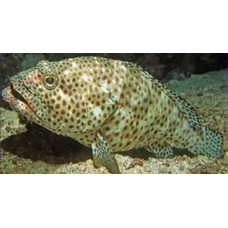Latin name
Epinephelus areolatus
Other names
Yellowspotted rockcod, areolate rockcod, green-spotted rock-cod, squaretail grouper, squaretail rock-cod.
Identification
Body covered with ctenoid scales. Body length less than head length, 2.8-3.3 times less than standard body length. Head length 2.4-2.8 times less than standard body length. Interorbital space convex. Forewing pointed, with 2-7 spines in corner. Upper edge of gill cover straight or slightly convex. Nostrils of equal size. Upper jaw perpendicular to posterior margin of eye. There are scales on both the upper and lower jaws. There are 2 lateral rows of teeth on the lower jaw. There are 8-10 gill stamens on the upper part of the gill arch and 14-16 on the lower part. The gill stamens are shorter than the gill lobes. Lateral line with 49-53 scales. Pyloric appendages 11-17.
Features of fish fins
Long dorsal fin with 11 hard barb rays and 15-17 soft barb rays; third or fourth barb ray slightly longer than the others. Anal fin with 3 hard and 8 soft rays, edge rounded or pointed. Pectoral fins with 17-19 rays, longer than pelvic fins. The pelvic fins extend to the anus. Caudal fin slightly convex in juveniles, truncate in adults.
Fish colouring
Head, body, and fins are gray or whitish with numerous closely spaced brown, brownish-yellow, or greenish-yellow spots. The largest spots are equal in size to the diameter of the eye. As the fish grows, the number of spots increases, but they become shallower. The pectoral fins are pale with small dark spots on the rays. The posterior edge of the caudal fin has a distinct white border.
Distribution
Widespread in the tropical and subtropical regions of the Indo-Pacific between 35°N and 33°S. Found from the Red Sea and Persian Gulf to the coastal waters of KwaZulu-Natal in South Africa. Further east the range extends to Fiji, northern Japan, the Arafura Sea and northern Australia. Absent from Micronesia, Polynesia, and most islands in the western Indian Ocean (Madagascar, Mascarene Islands, Comoros, Maldives, etc.).
Habitat
Marine benthic fish. Usually found in clusters of seagrass or over fine sandy substrates near rocky reefs, dead corals or eight-beam corals at depths of 6 to 200 meters. Juveniles prefer shallower waters down to 80 meters.
Size
Maximum body length 47 cm, usually 35 cm. Body weight reaches 1.4 kg.
Behavior
They live individually and do not form herds.
Food and feeding habits
They feed on fish and benthic invertebrates, mainly shrimp and crabs.
Reproduction
Like the majority of representatives of the genus, it is a successive protogynous hermaphrodite. At the beginning of the life cycle all individuals are exclusively female, and only a part of adult fish changes sex and becomes male. Females mature at a length of 19.5 cm, males at 29 cm. They form large aggregations during the spawning season. Fertilization is external. Eggs and larvae are pelagic.
Fishing
Valuable commercial fish. Fished throughout its range. Caught by longlines, trawls and pots. The object of sport fishing.
Relationship with a person
In some countries, artificial reproduction is practiced. Juvenile fish are captured from their natural habitat and raised in tanks, ponds and cages.
| Classification | |
| Phylum | Chordata |
| Class | Actinopterygii |
| Squad | Perciformes |
| Family | Serranidae |
| Genus | Epinephelus |
| Species | E. areolatus |
| Features | |
| Conservation status | Least Concern |
| Habitat | Pelagic |
| Life span, years | No information |
| Maximum body weight, kg | 1,4 |
| Maximum length, cm | 47 |
| Sailing speed, m/s | No information |
| Threat to people | Edible |
| Way of eating | Predator |
Areolate grouper
Tags: areolate grouper



